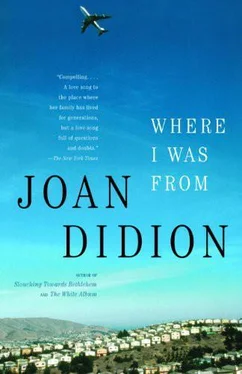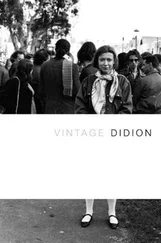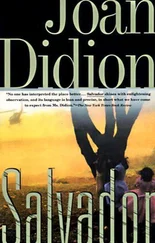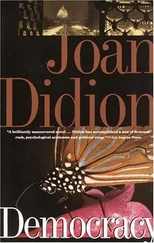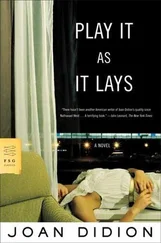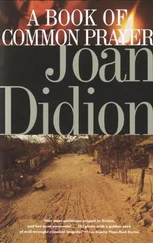For some miles she was silent.
California had become, she said then, “all San Jose.”
In the bar at the Claremont that evening someone was playing, as if to reinforce what had become a certain time-travel aspect in our excursion, “Only Make Believe,” and “Where or When.”
The smile you are smiling you were smiling then—
But I can’t remember where or when—
I had last been in the bar at the Claremont in 1955, with the son of a rancher from Mendocino County. I recall that I had my roommates driver’s license and a crème de menthe frappé. Thirty-eight years later, from the platform at the Charter Day ceremony, I glanced at the row where my mother was seated and found her chair empty. When I located her outside she told me that it had been essential to leave. She said that “something terrible” had happened during the academic procession, something that had made her fear that she would “cry in front of everybody.” It seemed that she had seen a banner reading “Class of 1931,” and had realized that the handful of men straggling along behind it (if there were any women she did not mention them) were having trouble walking.
The Class of 1931 had been my father’s class at Berkeley. “They were all old men,” my mother said about those few of his former classmates who had made the procession. “They were just like your father.” Frank Reese “Jim” Didion , the memorial note for my father had read in the alumni magazine. December 19, in Carmel. A native of Sacramento, where he was active as a real estate investor, he majored in business at Cal and was a member of Chi Phi. He is survived by his wife, Eduene, two children, Joan Didion Dunne ’56 and James ’62, and four grandchildren, including Steven ’88 and Lori ’93. There was no believable comfort I could offer my mother: she was right. They were all old men and it was all San Jose. Child of the crossing story that I was, I left my mother with Lori ’93 and took the United redeye from San Francisco to Kennedy, the last plane to land before a storm CNN was calling “The Nor’easter of the Century” closed every airport and highway north of Atlanta. I remembered this abandonment the day she died.
Ialso remembered this one.
Sacramento, July or August, 1971 or 1972.
I had brought Quintana — my daughter, then five or six — to spend a few days with my mother and father. Because it would be 105 at two and 110 before the sun went down, my mother and I decided to take Quintana out to lunch, somewhere with air conditioning.
My father did not believe in air conditioning.
My father in fact believed that Sacramento summers had been too cold since the dams.
We would go downtown, my mother said. We would have lunch in the Redevelopment. Old Sacramento. You haven’t even seen Old Sacramento, she said.
I asked if she had seen Old Sacramento.
Not exactly, she said. But she definitely wanted to. We would see it together, it would be an adventure.
Quintana was wearing a pinafore, pale green, Liberty lawn.
My mother gave her a big straw hat to wear against the sun.
We drove downtown, we parked, we started walking on what had been Front Street, its view of the Tower Bridge pretty much constituting the “adventure” part.
The sidewalks in the Redevelopment were wooden, to give the effect of 1850.
Quintana was walking ahead of us.
The lawn pinafore, the big hat, the wooden sidewalk, the shimmer of the heat.
My father’s great-grandfather had owned a saloon on Front Street.
I was about to explain this to Quintana — the saloon, the wooden sidewalk, the generations of cousins who had walked just as she was walking down just this street on days just this hot — when I stopped. Quintana was adopted. Any ghosts on this wooden sidewalk were not in fact Quintana’s responsibility. This wooden sidewalk did not in fact represent anywhere Quintana was from. Quintana’s only attachments on this wooden sidewalk were right now, here, me and my mother.
In fact I had no more attachment to this wooden sidewalk than Quintana did: it was no more than a theme, a decorative effect.
It was only Quintana who was real.
Later it seemed to me that this had been the moment when all of it — the crossing, the redemption, the abandoned rosewood chests, the lost flatware, the rivers I had written to replace the rivers I had left, the twelve generations of circuit riders and county sheriffs and Indian fighters and country lawyers and Bible readers, the two hundred years of clearings in Virginia and Kentucky and Tennessee and then the break, the dream of America, the entire enchantment under which I had lived my life — began to seem remote.
ON the afternoon after our mother’s funeral my brother and I divided what few pieces of furniture she still had among her grandchildren, my brother’s three children and Quintana. There was not much left; during the previous few years she had been systematically giving away what she had, giving back Christmas presents, jettisoning belongings. I do not remember what Quintana’s cousins Kelley and Steven and Lori took. I do remember what Quintana took, because I have seen the pieces since in her apartment in New York. There was an oval Victorian table with a marble top that had come to my mother from some part of the family, I no longer remember which. There was a carved teak chest that had been in my mother and father’s bedroom when I was a child. There was a small piecrust table that had been my grandmother’s. There was, from among my mother’s clothes, an Italian angora cape that she had been wearing ever since my father gave it to her, one Christmas in the late 1940s.
Actually I took the angora cape.
I remembered her wearing it the spring before, at the wedding in Pebble Beach, of my brother’s youngest child. I remembered her wearing it in 1964 at my own wedding, wrapping herself in it for the drive from San Juan Bautista to the reception in Pebble Beach.
A representative from Allied came.
The pieces got tagged for shipment.
I put what I did not want to be thrown away — letters, photographs, clippings, folders and envelopes I could not that day summon up the time or the heart to open — in a large box.
Some weeks later the box arrived at my apartment in New York, where it sat in the dining room for perhaps a month, unopened. Finally I opened it. There were pictures of me on the beach at Carmel in 1936, pictures of me and my brother on the beach at Stinson Beach in 1946, pictures of me and my brother and my rabbit in the snow in Colorado Springs. There were pictures of great-aunts and cousins and great-great-grandparents who could be identified only because our mother, on the evening before she died, had thought to tell the names to my brother, who wrote them on the backing of the frames. There were pictures of my mother as a two-year-old visiting her grandmother in Oregon in 1912, there were pictures of my mother at a Peterson Field barbecue in 1943, a young woman in her early thirties wearing flowers in her hair as she makes hamburgers. There was an unframed watercolor of my grandmother’s. There were letters my grandmother’s brother Jim, like her father a merchant sea captain, had sent her in 1918 from England, where his ship, the S.S. Armenia , was in drydock at Southampton after having been torpedoed. There were letters my father had written to his own father in 1928, from a summer job on a construction crew outside Crescent City — my father asking, in letter after letter, if his father could please put in a word for him with an acquaintance who did the hiring for the State Fair jobs, a plea I happen to know was in vain.
Читать дальше
Конец ознакомительного отрывка
Купить книгу
